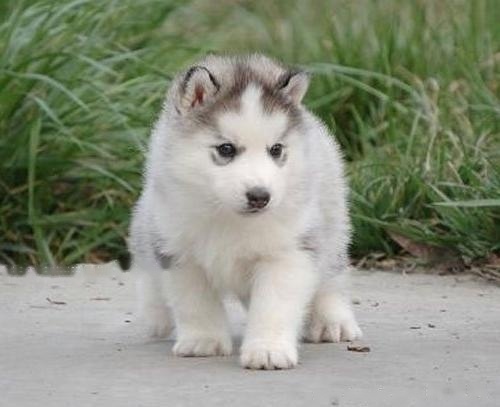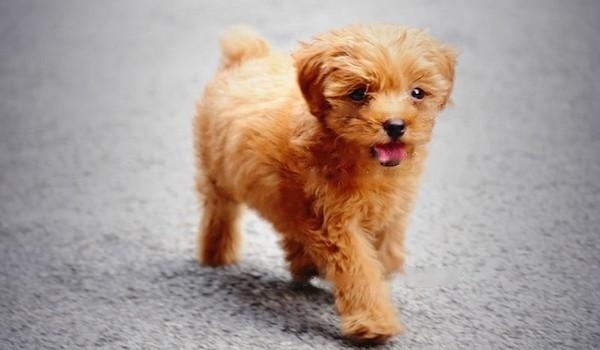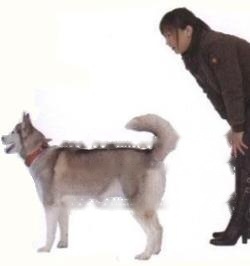Whether it is a human being or a pet, there is a best learning period for you. That time period can improve your learning ability and transform your character. The learning period and shaping period of a person are 1-6. 2-12 months old, the best time for dogs to learn and train is 2-12 months. During this period, owners can train dogs into their ideal dogs. Dog, what kind of training do dogs need between 2-12 months?

Husky
1. Excretion training (implemented after meals, the best effect) Fix the corner outside the kennel or in the bathroom and bathroom of the apartment, above Spread dry newspaper with its urine on it and place the newspaper on top. In order for the dog to understand that this is the place to pee, you have to put a bit of its waste [such as newspaper after the urine has dried] in it, because the newspaper has a familiar smell to it. At the beginning of the training, the scope of the newspaper should be as large as possible, and then gradually teach it to only solve in the newspaper. Remember to praise it immediately when it does the right thing; if not, rebuke it briefly and firmly. Once the location of the dog toilet is determined, it is best not to move it casually, so as to expand its range of activities in the home. But teach puppies, after one action is proficient, teach the next action, be patient.. Don't be too hasty...
2. No and very good training
When you see your dog behaving badly, stop it immediately. And issue a [No] password to let it know that this behavior is not allowed, and will be scolded by the owner. On the contrary, if the dog has good behavior or behavior, praise him immediately for issuing the [nice] password, and stroking his head or neck to let him know that his owner likes it.
3. Wait a moment and Come here training
The command Wait a moment is to temporarily stop the dog's movements. When eating, put the food in front of the dog, and then give the wait a minute password, and so on. If you want to train the action of come, you can do it when you are walking; if you call it to come, then praise it immediately; if it does not come or run away when you call it, don't get angry and chase after it. Go with the flow, call again after a while, and try to keep it within a distance of no more than 10 meters from you when you usually develop to let go of free activities. It is very important to develop the habit of rope traction from a young age (*especially when going out to cross the road, to avoid accidents~), go to an open place, let it go freely, if it is slightly away from you, you should greet it to come back , and develop a good habit of not staying away from the owner~
4. Sit down training - (the best effect is performed before meals)
I just started sending out the sit down The command, the dog cannot understand, it must press down on its back half with its hand, and at the same time issue the [sit down] password, until it can understand and sit down quietly.
5. Handshake training - (implemented before meals, the best effect)
Make sure that the dog is very familiar with the passwords and actions of sitting before it can be implemented. When it sits down quietly, please gently. Raise the left hand or right hand, shout the handshake password at the same time, repeat the implementation, when the dog can understand and listen to the handshake password, it is completed. The training should be repeated every day, remember when training, do not act too hastily and if you are unfamiliar with one action, teach another immediately. An action is the biggest taboo in training.
6. Lie down (lie down) training - (the best effect is before meals)
If you want When training the dog to lie down, you should find a quiet place, and when it has sat down quietly, pull the front feet with both hands to form a lying down position. As long as it is usually trusted by its owner, it is easy to train. Pat it and praise it.
7. Barking training
A puppy will wag its tail no matter who calls it, but for a large The same is true for dogs, so they lose their vigilance. Especially playful dogs, their physique is not strong enough. If they are too gentle, they will not only be unable to take up the job of housekeeping, but they may even be abducted and lost! The dog doesn't want to bark, it's impossible if you order it to bark, so it needs to be trained before eating. Before each meal, it will always bark excitedly and cooperate with the command of bark and bark, which is very Easy to do. In case it doesn't bark, after repeated commands, and there is no response, you can step on its feet or tail, or walk away. A daily habit of going out for walks Once the owner's time is up, if you don't take it out, the puppy will growl. All the above are just to let the dog know the owner's command to bark and what action to take. Of course, if it barks, it should be caressed and said. Secondly, after four or five months of the dog, don't let outsiders approach casually, so that the dog will have a vigilance about other people's random approach in addition to the owner. Food, at this time, the dog will naturally bark, the owner should give encouragement to say bark and bark, and give comfort and reward to build up its self-confidence. Trust the owner, but reject others. 8 , Don't bark training to stop barking
Contrary to the above situation, some dogs like to bark very much, which is really a headache, and also needs training . This training and the previously described training, albeit in reverse, are at the same pace. The main purpose is to let the dog know when to bark, and to stop barking when a guest comes. If you pick it up, it will make it misunderstood, thinking that it was right, but it should be strict. Say: Don't bark, or spank, so that the dog will naturally correct itself. The puppy lives alone in the kennel. It's too boring. After barking a few times, you come from other places. If there is nothing to blame, the dog will think that as long as it barks, the owner will come right away. The training can also be reversed before eating, and if the barking keeps barking, a don't bark command should be given. Any of the above actions, as long as there is a slight achievement and progress, should be patted on the muzzle next to the mouth to express your approval.
9. Go in training
The purpose of go in is mainly to order it to go into the dog house. At first, force it in with a pull strap or by hand, while giving the command in. Especially before going to sleep at night, when you come back from exercise, you can repeat it several times a day until you learn it. One of the things that must be noted is that the location of the dog house should not be changed frequently, so as not to cause confusion for the dog. Wait until you have learned the action of going in, you can try to do it without pushing by hand, but only by issuing commands. Then change the place, point out the direction and position with your fingers, and order it to be in place. The above practice actions are firstly mandatory behaviors, and then one command and one action, with clear rewards and punishments; if you love playing dogs indoors, the method is the same. If there is a dog house, you should make him enter the dog house, or sit in a specific place to show obedience.
10. Don't bite things training
Sometimes the dog bites the legs of the furniture, and it should be stopped and said no, or spanked. There are reasons why dogs like to bite things. When puppies are full of curiosity about the things around them, they play with objects as playmates, with their bodies down and their forelimbs forward. Secondly, when the puppies are 3 to 6 months after birth, when the deciduous teeth are going to be transformed into permanent teeth, they especially like to bite things, and the gums are itchy, resulting in a phenomenon of physiological desire. The third point is that a puppy with vigorous growth is too energetic and has nowhere to play, especially a puppy in the growing period. In addition to the methods of scolding and spanking, it should also be reviewed: (1) After entering the house, restrict it from playing in the kennel and playground. (2) Choose toys for it to play with, such as commercially available fake cowhide bones, hard balls, or things that are no longer used (dolls, shoes, etc.). (3) Increase the walking time and the amount of exercise outside. (4) During this time of hi-biting, put movable things up or put away. A puppy who has no biting habit at all, is either sick or has a bad temperament. As long as he is good at preventing the behavior of biting in a tank, he can still be taught well. At the same time, transfer its abundant energy to training, and then you can try it.
11. Bite Correction Training
Dogs tend to be nosy by nature, such as chasing moving things. This phenomenon is especially pronounced in puppies; if this phenomenon is not prohibited, it will also be neurotic, so it should also be trained together. In order to achieve the purpose of training, you can take it to the front of animals weaker than it. Seduce it, see when it wants to approach, stop no or slap it immediately, and pull it back with a pull strap, and try the same way in the same way. Let it know why the owner is dissatisfied. Or when the gold fish has been killed by it, you should push the dog's head to the stump and let it sniff it before scolding it, so that it understands why you are unhappy and then scold it. It, hit it. Others, such as potted plants outside the window, flowers and trees, etc., are also the same method. In addition, some small dogs will bite the heels of visitors. These puppies are usually fearful and protective. , it should be prevented as soon as possible. The dog bites are less harmful, and it is strictly trained at this time, and you can take it out with confidence when it grows up, so as not to cause danger. Otherwise, it is too troublesome to wear a mask on the road. One is often locked in a dog cage The dog, or the dog that is tied up, has been controlled for a long time in action, which is easy to cause physical and mental imbalance, and will have the appearance of biting. The owner neither takes it out nor plays with it, especially people who are not used to the outside world. And things, once a stranger approaches, they always think that they want to harm it, it is better to do it first. If a person is imprisoned in a small world for a long time, his body and mind will not be normal. The same is true for dogs.?… ...
12. Side-by-side follow-up training
The action of walking on the left side of the dog companion seems to be easy, but it is actually It needs to be taught, and this kind of training is very important. The population and vehicles in the city are very dense, and it is easy to cause danger and traffic accidents. Put the drawstring too long and make it move arbitrarily. After June, start to implement strict training, and cultivate the habit of sideways follow-up since childhood. After you get used to it, gradually lengthen the drawstring or not use it at all. Pull the belt [that is, follow the left side of the cordless foot in advanced movements]. If you may encounter an advanced situation during the practice, you should pull it back immediately. If you can't go, pull it away reluctantly. A pierced collar can also help You have finished training. The third situation is that the distance from the owner is too far, you can use the edge of the drainage channel or the fence to train it. Since there is a danger of falling in the ditch, it naturally has to walk on the side. During the training, it should be Reciprocal use of reward and punishment, but it is inconvenient to create a mentality of seeing walking as a fear of cloth.
![[Dog Training 5] The training method of pet dog dining etiquette](/static/img/12192/12192_1.jpg)




